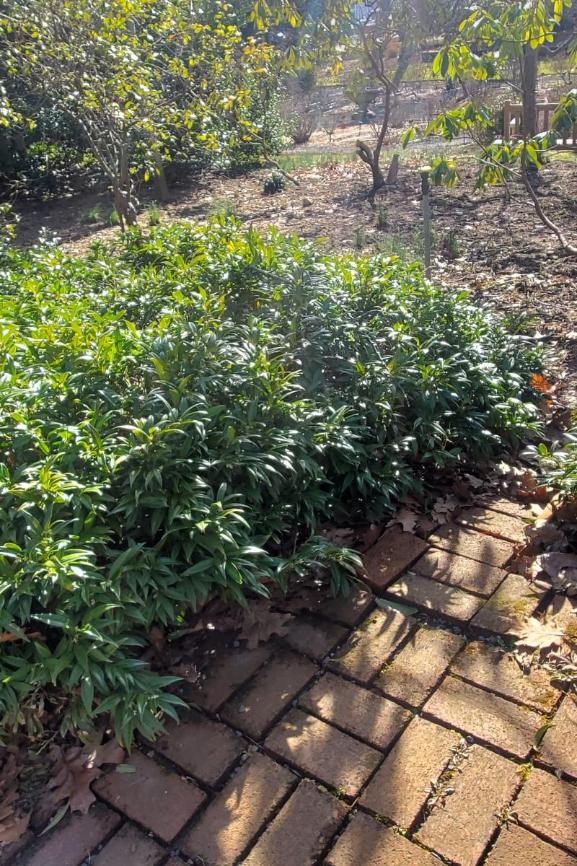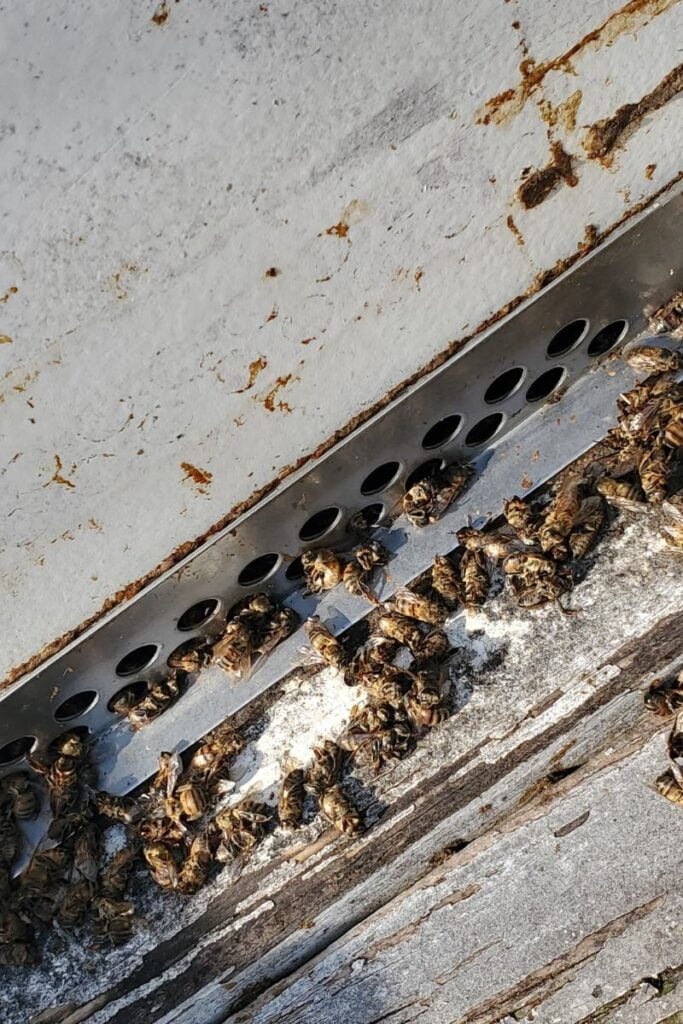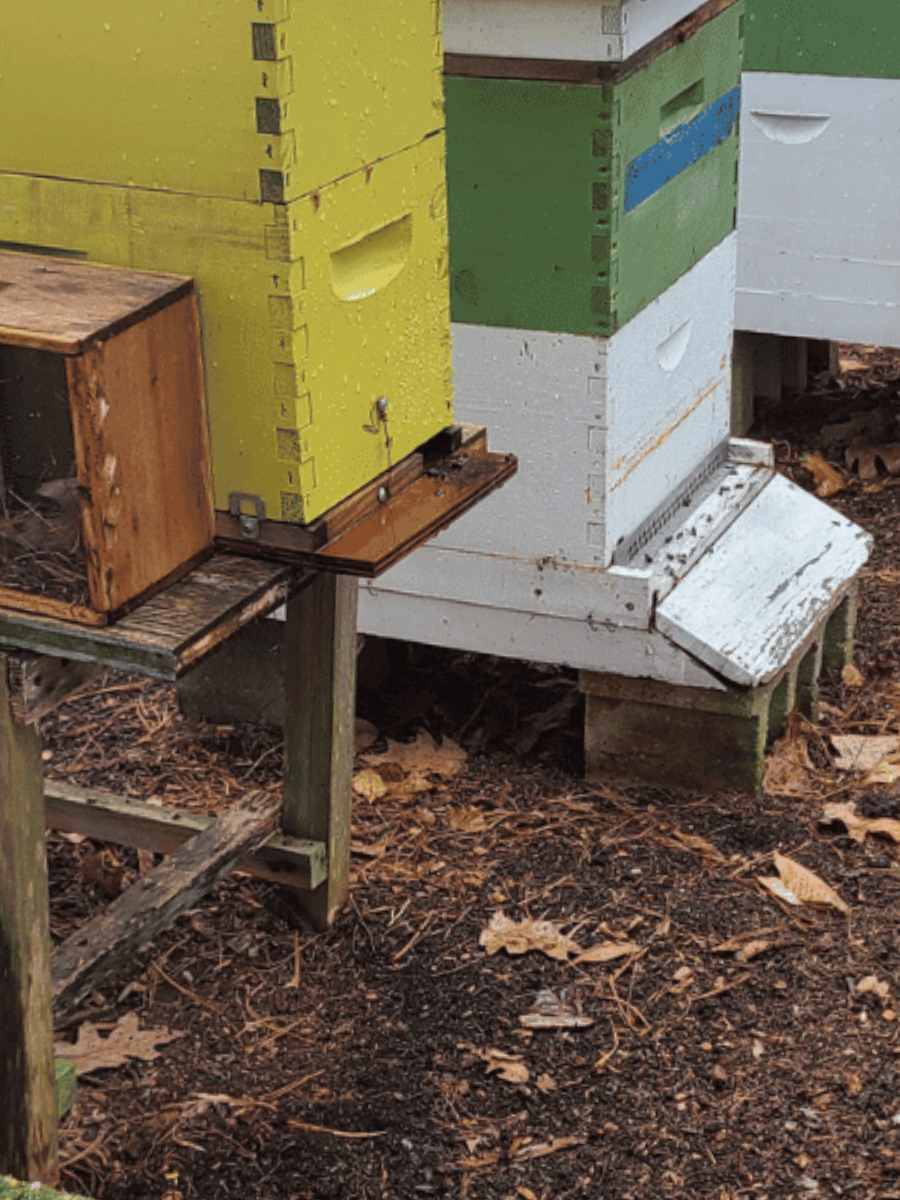The winter bee yard was a little chilly on February 29th for the kick-off of the Backyard Bees Apiary Series at Clark Botanic Garden. We wore hats, boots, gloves and scarves…and big smiles! Despite the weather, there was an excited buzz coming from the participants; they were all eager to learn about honey bees in the winter.

Table of Contents
Honey Bees In Winter: what did we do?
The more you learn about bees, the more you will appreciate the garden landscape in every season. The winter bee yard was only part of our focus for our session about honey bees in winter.
Here’s what we did to kick off our season at Clark Botanic Garden. We started with a walk from the front gate to the apiary.

In Bloom at Clark Botanic Garden
Thanks to our horticulturist, Bonnie Klein, the Queen was able to identify the name of this small shrub that grows along the path to the apiary – Fragrant Sweet Box (Sarcococca ruscifoli).
“Fragrant” is an understatement – the tiny white flowers are extremely aromatic! The honey bees love visiting Fragrant Sweet Box and on a warmer day in late winter/early spring, you will see the bees in action.
Fragrant Sweet Box is an excellent small evergreen shrub for shady areas and as you can see, it makes a great walkway hedge. The blooms turn into bright red ornamental fruit.
Introductions
No first meeting is complete without a little ice breaker and introductions. We played a little game called “Cross the Line” and we waggled our butts like a queen bee (we had to bee silly and it helped to warm us up!).
Winter Bee Yard Hive Basics
We went over terminology and examined all the parts of a beehive. Just as in nature, where bees make their home in different spaces, each hive in the apiary has it’s own setup, based on the equipment that was available when the bees were installed.
Here’s a description of what we saw in the winter bee yard using a few terms we went over. “The apiary at Clark Botanic Garden consists of 10 hives. We have a mix of 10-frame deep and medium supers. The bees primarily enter the hive on the bottom board, but they can enter at the top as well. Hives have an inner cover and an outer cover which are removed when the beekeeper needs to check on them. “

February Observations
Everyone was prepared with a notebook and writing utensils, but not everyone used them! It seemed that the predominant observation was the weather; it wasn’t exactly “sit in the sun and draw” kind of weather. (I’m sure March weather will be much better)
You don’t usually see honey bees in winter. Today was no exception, but it gave us a chance to really observe the hives where the honey bees live.
A hive consists of a bottom board, several supers (deep or medium), inner cover, and an outer cover. Each super at Clark Botanic Garden has 10 frames. The Apiary went into the 2023 winter with 10 live hives. Our first job of the season was to evaluate what happened over the winter.
| TOTAL # HIVES | 10 |
| Presumed dead: hives with significant dead bees on bottom board; too cold to investigate further | 5 |
| Weather on day of class | 40 degrees F |
| Number of participants | 23 |
| Plants in Bloom | Fragrant Sweet Box (Sarcococca ruscifoli) |
The Queen Bee inspected visited the winter bee yard the week before our group began. She reported that all 10 of the hives were alive. But Mother Nature tricked the bees – we had snow and a drop in the temperatures. When we started to observe the bee yard, we noticed dead bees…a significant number of them.


The bees were caught out in the cold, much the way that a human being can get caught in a blizzard. The bees landed on stone and concrete blocks that hold on to the sun’s warmth. But even though they were right next to the entrance (on the bottom board), they didn’t make it back inside to safety.
Topic of the Month: Survival Of Honey Bees In Winter
Honey bees are small; the average worker bee is about 1/2 inch long. We talked about the amazing ways that they are able to keep their tiny bodies warm and well-fed throughout the winter.
A beekeeper can help to keep the bees well-fed by leaving extra honey on the hives for the winter. They can also feed them extra honey, syrup, or feeding patties, depending on the temperature. A beekeeper never wants their bees to starve to death!
We talked about 3 ways that the bees stay warm in the winter and how they keep the temperature above 90 degrees F, no matter what the temperature outside! Social thermoregulation is a great term to impress people, isn’t it? If you missed class, read up on winter bees.
The bees are in charge of the temperature inside of the hive. They like it to be in the 90’s (the ideal temperature is 94-96 degrees F).
Bees are social thermoregulators; they work together to keep the hive nice and cozy by staying in a winter cluster. The walls of the beeswax cells help them stay warm inside a ‘room.’
They also have a system of releasing their body heat using their abdomens and their wings to fan and circulate warm air throughout the hive. We tried contracting and releasing our abdominal muscles but weren’t so successful at getting warmer!
You can read more about honey bees in winter and their survival mechanics in our article..
Thank You Surprises
The Queen loves surprises, don’t you? Everyone who attended got a package of Hudson Valley Seeds Midnight Garden Mix.
It’s always fun to grow something and to think a little “outside the garden bed.” A midnight garden is also called a “moon garden;” the flowers all tend to be white and to bloom later in the day.
Conclusion: Honey Bees In Winter – weak or strong?
Nature is amazing. Despite the number of dead bees, the Queen remains optimistic about the overwintering health of the bees. As long the honeybees form a cluster inside the hive, protecting the Queen, the winter bee yard may be stronger than we think.
We observed a significant number of dead bees on the bottom boards of five hives, which equates to 50% of the hives in our apiary. That’s on par with the national mortality rate for hives, with about beekeepers losing about 45% of their managed hives.
The Queen likes to be above average, or in this case, below. Spring starts on March 19th and until then, she will bee optimistic that only two hives succumbed to the stresses of the winter bee yard. Let’s see what happens in March!
Register and Follow Along
If you want to bee a part of our free apiary series, please register so we can stay in touch. If you’d like to support the Backyard Bees Apiary, we welcome donations for purchase of supplies. We are specifically working towards an observation hive which costs approximately $300.
Our next meeting is on March 28th and I’m excited to see the changes with you! We’ll send you a reminder e-mail and you can message us if you have any outstanding questions. You can also follow Backyard Bees over on our Facebook page or Instagram account.
BEE WELL! xoxo The Queen Bee!



